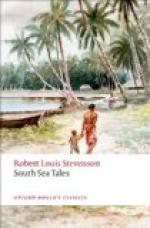The truth is, the tales are not necessarily consistent in themselves; and they are further darkened for the stranger by an ambiguity of language. Ghosts, vampires, spirits, and gods are all confounded. And yet I seem to perceive that (with exceptions) those whom we would count gods were less maleficent. Permanent spirits haunt and do murder in corners of Samoa; but those legitimate gods of Upolu and Savaii, whose wars and cricketings of late convulsed society, I did not gather to be dreaded, or not with a like fear. The spirit of Aana that ate souls is certainly a fearsome inmate; but the high gods, even of the archipelago, seem helpful. Mahinui—from whom our convict-catechist had been named— the spirit of the sea, like a Proteus endowed with endless avatars, came to the assistance of the shipwrecked and carried them ashore in the guise of a ray fish. The same divinity bore priests from isle to isle about the archipelago, and by his aid, within the century, persons have been seen to fly. The tutelar deity of each isle is likewise helpful, and by a particular form of wedge-shaped cloud on the horizon announces the coming of a ship.
To one who conceives of these atolls, so narrow, so barren, so beset with sea, here would seem a superfluity of ghostly denizens. And yet there are more. In the various brackish pools and ponds, beautiful women with long red hair are seen to rise and bathe; only (timid as mice) on the first sound of feet upon the coral they dive again for ever. They are known to be healthy and harmless living people, dwellers of an underworld; and the same fancy is current in Tahiti, where also they have the hair red. Tetea is the Tahitian name; the Paumotuan, Mokurea.
PART III: THE GILBERTS
CHAPTER I—BUTARITARI
At Honolulu we had said farewell to the Casco and to Captain Otis, and our next adventure was made in changed conditions. Passage was taken for myself, my wife, Mr. Osbourne, and my China boy, Ah Fu, on a pigmy trading schooner, the Equator, Captain Dennis Reid; and on a certain bright June day in 1889, adorned in the Hawaiian fashion with the garlands of departure, we drew out of port and bore with a fair wind for Micronesia.




